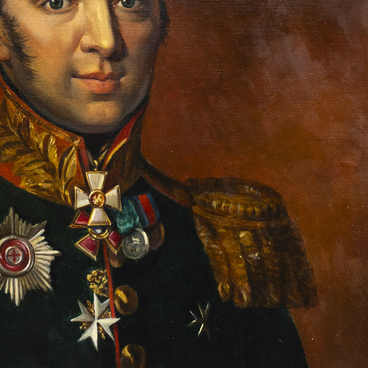Baron Karl Heinrich Georg von Bistram or Karl Ivanovich Bistrom came from a noble family from the Governorate of Estonia. In 1784, he was enlisted as a corporal in the Izmailovsky Life Guards Regiment. Six years later, he became a captain in the Nevsky Infantry Regiment.
He participated in the Russo-Swedish War of 1788–1790. In 1805, he became the commander of the 20th Jaeger Regiment and received the rank of colonel. In the campaign of 1806, he distinguished himself in the Battle of Czarnowo, for which he was presented with the Order of St. George, 4th class. Later, he took part in the most important battles with the troops of Emperor Napoleon I.
Near Pultusk, Bistrom was wounded in the left leg, near Preussisch-Eylau — in the left shoulder, near Guttstadt — in the right cheek with damage to the jaw. In 1809, he was appointed commander of the Life Guards Jaeger Regiment.
In 1812, Karl Bistrom participated in the defense of Smolensk. He distinguished himself in the Battle of Borodino and was promoted to major general in November. While pursuing the retreating enemy in the battles near Krasnoi, his regiment captured Marshal Louis-Nicolas Davout’s baton, nine guns and the banner. For such triumphs, the baron was awarded the Order of St. George, 3rd class.
In the campaign of 1813, he participated in the battles of Lutzen, Bautzen, Kulm and Leipzig (for which he was presented with the golden sword “For Bravery” with diamonds). After the capture of Paris, he received the Order of St. Anna, 1st class. In 1824 he was promoted to lieutenant general, and in 1825 he was appointed commander of the entire infantry of the Imperial Russian Guard.
Karl Bistrom’s portrait was painted by the English artist George Dawe in the 1820s. This work, among others, was placed in the Military Gallery of the Winter Palace. Dawe was partial to a romantic aesthetic, which is why the general in the portrait does not look directly at the viewer. Instead, he is slightly turned, gazing upwards into the distance.
The artist depicted Bistrom in the general’s uniform of the Life Guards Jaeger Regiment of the 1818 model with the star of the Order of St. Anna, 1st class, along with the badges of the Orders of St. George, 3rd class and St. Vladimir, 3rd class, the commander’s cross of the Order of St. John of Jerusalem, silver and bronze medals “In memory of the Patriotic War”, as well as the insignia of the Order of the Red Eagle, 2nd class, the order “For Merit”, and the Kulm Cross (the last three were Prussian awards).
George Dawe’s portraits of generals quickly acquired the status of canonical images of the heroes of the Patriotic War of 1812. The Borodino Museum-Reserve houses a reproduction of Dawe’s portrait made by an unknown 19th-century artist. The canvas was acquired in the 1960s.


